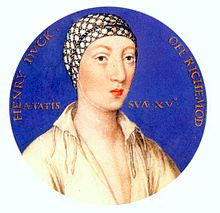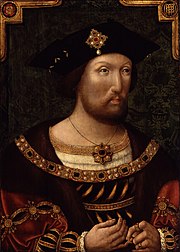Henry Fitzroy, 1st Duke of Richmond and Somerset
Henry Fitzroy, 1st Duke of Richmond and Somerset (born June 15, 1519 in Blackmore , Essex , † July 23, 1536 in London ), was the illegitimate son of Henry VIII with his lover Elizabeth Blount . It was the only illegitimate offspring that Henry VIII officially recognized. Beloved by his father and showered with royal dignity, he thought during his lifetime that one day he might become the next King of England before an early death at the age of only 17 overtook him.
Life
Meaning of his birth
When Henry Fitzroy was born, his father, King Henry VIII, had been married to his Queen Catherine of Aragon for ten years . Despite at least six pregnancies of the queen, only one child, Princess Maria , survived the first weeks of life and the king waited longingly for a male heir to the throne to be born. Henry Fitzroy's birth confirmed that he was at least capable of fathering healthy sons. He is said to have been delighted to have celebrated a lavish party on the occasion of the birth of his son and gave him the surname Fitzroy - son of the king.
Henry Fitzroy's godfather was Cardinal Thomas Wolsey , confidante and at the same time most important minister of the English king. The boy also grew up in his household. The affair between his mother and the English king does not seem to have lasted long after the birth of Henry Fitzroy. She was married in 1522, with Wolsey's help, to Gilbert Tailboys, who received a number of awards from the English king and was later promoted to baron. By this time the king already had a new mistress, Mary Boleyn .
Elevation to Duke and question of succession
After his father had already accepted him as a knight in the Order of the Garter in April 1525 , shortly after his sixth birthday, on June 18, 1525, Fitzroy was raised in a solemn ceremony to the Earl of Nottingham and then the Duke of Richmond and Somerset . These titles were all linked to the royal family (Richmond was the title given to Henry VII , Fitzroy's grandfather, before his coronation). Fitzroy was given priority over all other subjects, except for a legitimately born son.
In addition, the boy were given the offices of Lord Admiral of England, Lieutenant-General north of the Trent and Warden-General of the Marches against Scotland . Such a collection of titles and offices had never before been given to an English subject, let alone a child. In addition, a separate household with a council and all important budget officers was set up for Fitzroy in Sheriff Hutton Castle in Yorkshire , where he should be the nominal head of a regional government for the north. This gave Fitzroy the same symbolic meaning as a legitimate prince, for royal children were often sent to the borders of the empire as nominal regional rulers.

The implication of this remarkable elevation of his son was plain. Even after 16 years of marriage, the king did not have a legitimate son and this would remain so, because the now 40-year-old queen was no longer of childbearing age. The queen, whose mother had herself been the legitimate ruler of Castile , saw no problem in a female line of succession and prepared her daughter Maria as heir to the throne. But England had never had a queen before, and the king, like many of his subjects, feared that a Queen Mary would inevitably make England a vassal state to her husband once she married.
So, with Fitzroy's uprising, it seemed like the king was preparing his bastard son as the future king, and the queen made her displeasure clear. The following month, Princess Maria was also given her own large household and sent to Ludlow Castle in Wales as the nominal regent , as was traditionally the custom for the heir to the throne.
Apparently the king could not choose between his illegitimate son and his legitimate daughter.
marriage
Even in his childhood, possible marriages for Henry Fitzroy were repeatedly considered, including with a Spanish princess. Even if illegitimate, as the son of the King of England and possible heir to the throne, he was a valuable figure in the field of marriage policy in Europe, which was also recognized by foreign observers. After all, he was "already equipped to hold the state like a great prince and could easily be raised to higher things by the king". At short notice, the papal envoy Campeggio even proposed to issue a dispensation that would allow him to marry his sister Maria in order to solve the problem of the English succession and to distract the king from his divorce plans.
The marriage that the 15-year-old Fitzroy finally entered into was therefore surprising, because his bride was not a foreign princess, but Lady Mary Howard, the eldest daughter of Thomas Howard, 3rd Duke of Norfolk . The marriage was one of the ambitious marriage projects with which the Duke of Norfolk wanted to strengthen the Howards' influence and was so successfully promoted to the king by Queen Anne Boleyn , Norfolk's niece and Mary's cousin, that, surprisingly, the king did not even receive a dowry from the bride demanded.
Apparently, however, the marriage did not consummate because after Fitzroy's death two years later, Mary had great problems claiming her widow's pension.
death
Henry Fitzroy's promising career came to an end when he died on July 23, 1536, just a few weeks after his 17th birthday, at St James's Palace in London. He had been known to be ill for some time and doctors had diagnosed him as " consumptive and incurable". It could also have been another serious lung disease.
Modern biographers also consider a poison attack on the king's son to be possible. The reason, for example, the Catherine Howard biographer Joanna Denny assumes that Henry Fitzroy was planning a military uprising against his father.
Fictional representation
The Canadian fantasy author Tanya Huff built Henry Fitzroy into her Blood ... book series: Henry Fitzroy let himself be transformed by his lover, a vampire, of his own free will. The storyline of the book series is the present, but references to historical events or people are occasionally made. Building on this series of books, Henry Fitzroy also appears as a character in the Canadian series Blood Ties .
In the television series The Tudors Henry Fitzroy appears also died there but already the age of three at the welding disease .
literature
- Beverly A. Murphy: Bastard Prince, Henry VIII's Lost Son. Reissue. The History Press, Stroud 2004, ISBN 0-7509-3709-2
- Joanna Denny: Katherine Howard. A Tudor Conspiracy. Portrait, London 2005, ISBN 0-7499-5120-6
Web links
- Webpage about Henry Fitzroy
- Article in The Guardian about investigations into Fitzroy's crypt 2011
Individual evidence
- ^ A b Beverley A. Murphy: Bastard Prince: Henry VIII's Lost Son . Sutton, 2001, ISBN 0-7509-2684-8 , pp. 31-39.
- ↑ [1] Hall's chronicle: containing the history of England, during the reign of Henry the Fourth, and the succeeding monarchs, to the end of the reign of Henry the Eighth, in which are particularly described the manners and customs of those periods. Carefully collated with the editions of 1548 and 1550 , London 1809, p. 703
- ↑ David Starkey. Six Wives , Harper Collins, 2003, p. 198
- ^ Lucy Wooding: Henry VIII, Routledge Historical Biographies, London New York 2009, p. 121
- ↑ Lee and Wolsey, April 17, 1527 "is already furnished to keep the state of a great prince, and yet may be easily by the King's means exalted to higher things"
- ^ Letter from the imperial ambassador Chapuys dated July 8, 1536 "the duke of Richmond, who, in the judgment of physicians is consumptive (tysique), and incurable"
- ↑ Denny, pp. 75-78
| predecessor | Office | successor |
|---|---|---|
| New title created |
Duke of Richmond 1525-1536 |
Title expired |
| New title created |
Duke of Somerset 1525-1536 |
Title expired |
| personal data | |
|---|---|
| SURNAME | Fitzroy, Henry, 1st Duke of Richmond and Somerset |
| BRIEF DESCRIPTION | The illegitimate son of Henry VIII of England |
| DATE OF BIRTH | around June 1519 |
| PLACE OF BIRTH | Blackmore (Essex) |
| DATE OF DEATH | July 23, 1536 |
| Place of death | St James's Palace , London |



